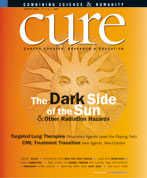Publication
Article
CURE
v4n2 - Monitoring CML: One Cell in a Million
Author(s):
Swapping of genetic material between chromosomes 9 and 22, a chromosomal translocation called the Philadelphia chromosome, causes CML.
Swapping of genetic material between chromosomes 9 and 22, a chromosomal translocation called the Philadelphia chromosome, causes CML. The Philadelphia chromosome encodes a new set of instructions for making an abnormal fusion protein known as bcr-abl, a tyrosine kinase that cannot be turned off and constantly stimulates the white blood cells to grow and multiply.
An accurate diagnosis of CML is confirmed by the Philadelphia chromosome using conventional chromosome analysis, new labeled chromosome probes (fluorescent in situ hybridization, or FISH), or molecular probes using a technique called polymerase chain reaction (PCR), which is widely used for DNA fingerprinting analysis in paternity and criminal cases.
Currently, there are several screening methods for detecting the abnormally short Philadelphia chromosome. The most common is a bone marrow aspiration from the hip bone that involves extracting chromosomes from dividing leukemia cells. The method is painful and because only a few cells can be scored, it may lead to a false-negative result. But it is still a useful test because it can detect other chromosomal abnormalities that occasionally can be seen in CML patients.
FISH uses fluorescent molecular probes to locate the chromosomal positions of bcr and abl. If the two genes are fused together in a single chromosome, their presence near each other can be detected by the change in color. False positives may occur if the two genes happen to be close together.
FISH is more sensitive than the conventional chromosome analysis in detecting the Philadelphia chromosome and can detect up to one abnormal cell in 100. As it does not require dividing cells, FISH can be done with a blood sample as opposed to a bone marrow biopsy. Recently, laboratories have started doing FISH using double fusion probes that score the presence of bcr-abl twice in each cell. This increases the sensitivity and decreases the number of false-positive results.
But the most sensitive method for detecting specific bcr-abl mutations is reverse transcriptase PCR (RT-PCR). RT-PCR amplifies a specific DNA sequence in a drop of blood and reads the pattern of the bcr-abl protein. Its high sensitivity can detect even a single leukemia cell with the Philadelphia chromosome among a million normal white blood cells. The test can detect any residual CML disease after a stem cell or bone marrow transplant or monitor the response to a targeted therapy, such as Gleevec.
Quantitative RT-PCR tests can measure the actual number of leukemia cells. Results can vary across laboratories, so it is best to get the test done at the same laboratory. Since RT-PCR has the possibility of false positives and false negatives, the test is usually repeated on a regular basis to uncover any trends.






